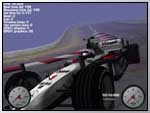This page describes how you can fiddle with the graphics. All
the settings are in racer.ini (which is located in your Racer
installation directory).
- resolution.fullscreen; if set to 1, fullscreen is
used
- resolution.width; sets the width of the window/screen
- resolution.height; sets the height of the window/screen
- resolution.bits; 16 or 32 bits (32 recommended)
- resolution.frequency; refresh frequency (Mac only)
- resolution.gamma; fullscreen gamma (Mac only)
- resolution.monitors; number of monitors across which
the view is shown. Normally this is 1. For Matrox Parhelia cards, you
can set this to 3 to get Surround Gaming (for example 2400x600 = 3x
800x600, so set monitors to 3 and width to 2400). These days you might use an nVidia GTX690 to do surround rendering. See this page for more uptodate information on surround rendering/gaming.
|
All rendering options are prefixed with 'renderer'.
The renderer is used from Racer v0.5.2 on.
- paint.triangles; render filled triangles?
Defaults to 1.
- paint.normals; render normals at each vertex?
- paint.wireframe; render wireframe of all polygons?
- use_array_elements; if set to 1 (default is 0, meaning
off), this will use an alternate method of drawing the polygons. This
was used during debugging and probably doesn't do much good for users.
- single_pass; if set to 1, the renderer will always
use single pass rendering. Use this in case of trouble with the default
(multitextured) state.
|
- window.manage; if set to 1, this let's
X11 manage the window. This means a border and draggability.
|
- fx.interval; the time between each
FX processing in ms
- fx.fog; use fog? (1=enable, 0=disable)
- fx.fog_hint; specify the approximation
of the fog. 0=don't care, 1=fastest, 2=nicest.
- fx.visibility; defines the drawing
distance in meters. Somewhere around 500-1000 is recommended. Can make
quite a huge difference in framerate.
- fx.track_lighting; always enabled
for Racer v0.5.2+.
- fx.sky_enable; draw the sky? Always
enabled.
- fx.skid_mark_buffer
- fx.skid_mark_enable
- fx.sun; specifies sun parameters (the
sun location itself is stored per track).
|
- fx.smoke.particles; defines the maximum number of
smoke particles. The lower the number, the higher the framerate can
stay when lots of smoke is generated.
|
- mirrors.simple.enable; if 1, turns on a simple rectangular
mirror at the top of the screen. This requires mirrors.texture.enable
to be turned on starting in Racer v052b6.
- mirrors.simple.wid; width of the mirror polygon (based
on a 800x600 view).
- mirrors.simple.hgt; height of the mirror polygon
(based on a 800x600 view).
- mirrors.texture.enable; if 1, turns on rendering
of a mirror texture. This texture (knowns as a special map named '$mirror'
for the shaders) will be updated live every frame to match the rear
view of the focused car. Very useful to create live mirrors on the car.
- mirrors.texture.wid; the width of the mirror texture.
Use a small value (never wider than the window size you're at) like
256.
- mirrors.texture.hgt; the height of the mirror texture.
Can be smaller than the width. Say width=256, height=64 for starters.
The larger these two values, the more performance is lost rendering
the mirror.
- mirrors.texture.fov; the field-of-view (in degrees)
used in mirror rendering.
|
- textures.quality; this is a downscale option to reduce
the size of texturemaps. Normally it is 1 to use the actual image size.
If you have low framerates, increase this to 2, 4, 8, 16 or more, as
long as it's a power of 2. For example, 8 will downsize the images 8
times, giving small texturemaps. Those look more blurry, but in general
give higher framerates.
- textures.max_wid; this specifies the maximum texture
size. Useful for detail tweaking, or older graphics cards which can't
use anything above 256x256 for example.
- textures.max_hgt; this specifies the maximum texture
height.
|
- lod.enable; set this to 1 to enable LOD (the default)
or 0 to ignore any LOD modeling. Setting it to 1 is highly recommended.
- lod.factor; this factor is used on all LOD distances.
Normally 1 for the designed LOD distance. Values under 1 will make LOD
models being used quicker (a value of 0 even removing all LOD models),
and values over 1 will avoid LOD kicking in too soon (if you have the
CPU power to spare!).
More information on level of detail settings can be found on a separate page. |

